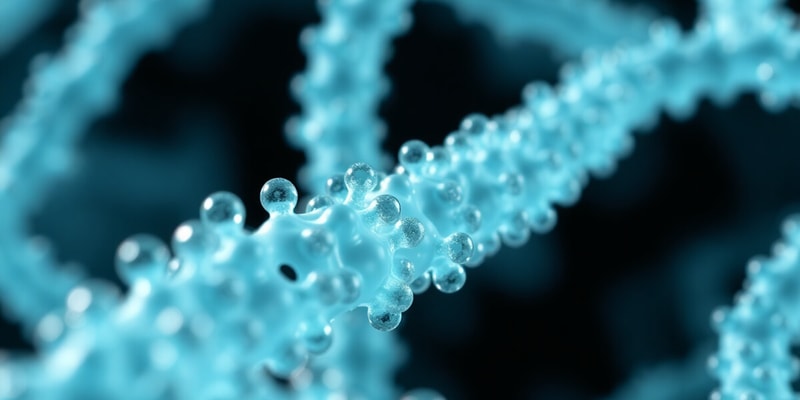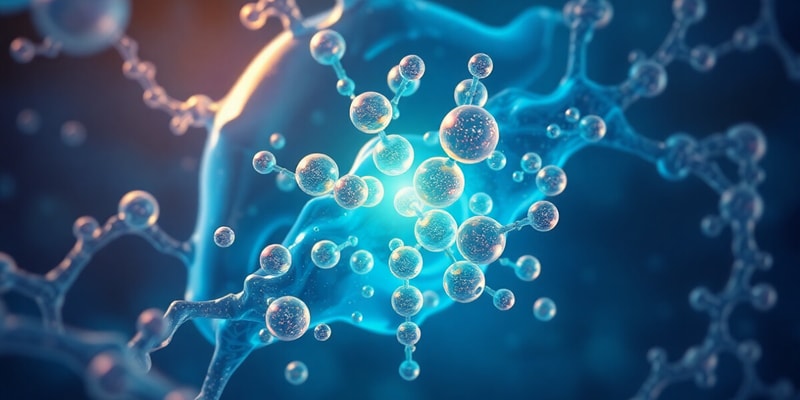Podcast Beta
Questions and Answers
Which of the following accurately describes the solubility characteristics of lipids?
What type of lipid primarily serves as the main energy reserve in organisms?
What distinguishes a glycerophospholipid from a sphingophospholipid?
Which of the following lipids contains carbohydrates in its structure?
Signup and view all the answers
In terms of insulation in organisms, which type of lipid is primarily responsible for thermal insulation?
Signup and view all the answers
What is the primary role of triacylglycerols in biological systems?
Signup and view all the answers
Which statement accurately describes the solubility properties of triacylglycerols?
Signup and view all the answers
What is the consequence of lacking lecithins in neonates?
Signup and view all the answers
What type of reaction can hydrolyze triacylglycerols?
Signup and view all the answers
Which of the following correctly identifies the structure of glycerophospholipids?
Signup and view all the answers
What characteristic distinguishes saturated fatty acids from unsaturated fatty acids?
Signup and view all the answers
Which fatty acid is specifically cited as a precursor of inflammation and pain?
Signup and view all the answers
What structural feature of unsaturated fatty acids contributes to their lower melting points?
Signup and view all the answers
How do trans fatty acids primarily differ from naturally occurring unsaturated fatty acids?
Signup and view all the answers
What is the significance of the even number of carbon atoms in naturally occurring fatty acids?
Signup and view all the answers
Which of the following statements about eicosanoids is true?
Signup and view all the answers
What is a significant health impact of trans fatty acids based on lipid metabolism?
Signup and view all the answers
Why is the oxidation of unsaturated fatty acids a concern in biological systems?
Signup and view all the answers
What is a primary consequence of Vitamin D deficiency?
Signup and view all the answers
Which of the following describes a role of vitamin A?
Signup and view all the answers
Which lipid class includes compounds critical for signaling cascades?
Signup and view all the answers
Which type of fatty acids are considered essential for physiological functions?
Signup and view all the answers
What is the main structural feature of glycosphingolipids?
Signup and view all the answers
Which property of phospholipase is related to its specificity?
Signup and view all the answers
What is the primary physiological function of triglycerides?
Signup and view all the answers
Which statement accurately describes sterols?
Signup and view all the answers
What is the role of glycosphingolipids in the human body?
Signup and view all the answers
How do steroid hormones primarily travel in the bloodstream?
Signup and view all the answers
Which enzyme is activated by the release of Inositol 1,4,5-triphosphate (IP3)?
Signup and view all the answers
What characteristic structure is common to all sterols, including cholesterol?
Signup and view all the answers
What is the primary function of plasmalogens in vertebrate heart tissue?
Signup and view all the answers
Arachidonic acid is primarily involved in which type of biological process?
Signup and view all the answers
What type of lipids are released from basophils and play a role in inflammation?
Signup and view all the answers
Which of the following statements accurately describes eicosanoids?
Signup and view all the answers
What distinguishes synthetic steroids from natural ones in function?
Signup and view all the answers
What occurs after the activation of Protein Kinase C?
Signup and view all the answers
What is the primary structural feature that allows sterols to be effective in cell membrane composition?
Signup and view all the answers
What happens to cholesterol when it is excreted from the body?
Signup and view all the answers
The formation of diacylglycerol (DAG) is associated with which membrane process?
Signup and view all the answers
What is the primary role of phospholipids in cellular membranes?
Signup and view all the answers
Study Notes
Lipids: Overview
- Lipids are a heterogeneous group of compounds that are either related to fatty acids or potentially related to fatty acids.
- Fatty acids are long carbon chain carboxylic acids that can be saturated or unsaturated.
- Lipids are insoluble in water but soluble in non-polar solvents.
- Lipids can self-assemble to form bilayers, micelles, and other structures because of their hydrophobic effect.
Roles in Organisms
- Lipids play a crucial role in maintaining organism function.
- Dietary lipids are a high-energy source and provide essential fatty acids, vitamins, and essential fatty acids (EFAs).
- EFAs include linolenic acid (C-18, 3 unsaturated bonds) and linoleic acid (C-18, 2 unsaturated bonds).
- Lipids serve as the primary energy reserve for the body.
- Adipose tissue acts as a thermal insulator and also provides electrical insulation for nerve cells.
- Lipids are involved in the formation of membranes, transport systems, and signaling pathways.
Derivatives of Fatty Acids
- Simple lipids are esters of fatty acids (FA) with various alcohols.
- Fats are esters of FAs with glycerol.
- Liquid fats are classified as oils.
- The melting point of a fat depends on the percentage of saturated fatty acids and the molecular weight.
- Waxes are esters of FAs with high molecular weight alcohols.
- Fats are esters of FAs with glycerol.
- Complex lipids are esters of FAs containing other groups besides alcohol and FA.
-
Phospholipids:
- Glycerophospholipids: glycerol serves as the alcohol.
- Sphingophospholipids: sphingosine acts as the alcohol.
- Glycolipids: contain a FA, sphingosine, and carbohydrate.
- Other complex lipids: lipoproteins
-
Phospholipids:
- Precursor and derived lipids: FAs, steroids (C30), terpenes, glycerol (Neutral Lipids)
Fatty Acids (FA)
- Long chain carboxylic acids.
- Naturally occurring FAs usually have an even number of carbon atoms due to their biosynthesis from C2 fragments (AcCoA).
- FAs can be saturated or unsaturated and this significantly affects their physical and chemical properties.
- Saturated FAs have higher melting points and tend to form more rigid structures.
- Unsaturated FAs have lower melting points and can form more dynamic and flexible structures (think of cell membranes).
Essential Fatty Acids
- Essential fatty acids cannot be synthesized by the body and must be obtained from the diet.
- Arachidonic acid is an important EFA and is a precursor to a variety of inflammation-related compounds.
Unsaturated Fatty Acids
- Mono- or polyunsaturated fatty acids (PUFAs).
- PUFA nomenclature:
- Chemists count from the carboxyl carbon.
- Physiologists count from the omega (ω) carbon.
-
Eicosanoic fatty acids (EFAs), particularly arachidonic acid, are essential precursors for prostaglandins, leukotrienes, thromboxanes, and prostacyclins.
- These compounds are important lipids involved in inflammation and pain responses.
Unsaturated Fatty Acids: Properties and Implications
- Due to the presence of double bonds and their specific geometry, unsaturated FAs have low melting points, which is relevant for membrane fluidity.
- Unsaturated FAs are susceptible to oxidation, leading to rancidity, tissue damage, and potential involvement in cancer and inflammation.
-
Trans fatty acids are rare in nature, but can be produced during lipid metabolism and the processing of vegetable oils and margarine.
- Trans FAs have been linked to increases in plasma cholesterol levels and are frequently listed on food labels.
Triacylglycerols (Triglycerides)
- Triacylglycerol molecules are triesters of glycerol with fatty acids.
- The fatty acid chains in triacylglycerols can be identical (e.g., tripalmitin, tristearin) or different.
- Triacylglycerols are non-polar and water-insoluble because the polar groups (-COOH, -OH) are condensed.
- They have lower density than water and are excellent thermal and electrical insulators.
Triacylglycerol Function
- Triacylglycerols are involved in energy storage.
- The distribution of fatty acids varies across different fats and oils.
- Triacylglycerols can be hydrolyzed in basic or enzymatic (lipases) environments.
Waxes
- Waxes are esters of FAs with high molecular weight alcohols.
- They serve as energy stores, water-repellent materials, and are often used in pharmaceuticals and cosmetics.
Glycerophospholipids
- General structure:
- Key components of cellular membranes.
Lecithins
- Lecithins, such as dipalmitoyl phosphatidyl choline (DPPC or dipalmitoyl lecithin), are important surfactants.
- Surfactants decrease surface tension.
- DPPC is essential for proper lung function.
- Neonates lacking sufficient DPPC can experience Respiratory Distress Syndrome (RDS).
Lipids with Ether Linkages
- Found in vertebrate heart tissue (plasmalogens).
- Released from leukocytes (basophils).
- Stimulate platelet aggregation and serotonin release.
- Play important roles in inflammation and allergic responses.
Sphingolipids
- Sphingolipids are based on the amino alcohol sphingosine.
- They are important components of cell membranes.
Glycosphingolipids and Blood Types
- Glycosphingolipids play a crucial role in determining ABO blood types.
Enzymatic Degradation of Phospholipids: Specificity of Phospholipases
- Phospholipases are enzymes that break down phospholipids by cleaving specific bonds within the molecule.
- They are important in various cellular processes, but their action can also contribute to disease development.
Sterols
- Sterols are structural lipids found in eukaryotic cell membranes.
- Sterols contain a characteristic steroid nucleus, which is planar and rigid.
- Cholesterol is a crucial example of a sterol, which is involved in a variety of cellular functions:
- Cholesterol is a key component of cell membranes.
- Cholesterol is excreted as bile acids.
Lipids: Signaling Role
- Many lipids have signaling roles.
- These lipid signaling molecules can act as hormones, vitamins, and intracellular messengers.
- Phosphatidylinositol-4,5-bisphosphate (PIP2) is an example of a lipid signaling molecule involved in the activation of various signaling cascades.
Eicosanoids: Paracrine Hormones
- Eicosanoids, such as prostaglandins, leukotrienes, thromboxanes, and prostacyclins, are bioactive lipids that act as paracrine hormones.
- Paracrine hormones exert their effects locally, influencing the cells in their immediate environment.
Steroid Hormones
- Steroid hormones are oxidized derivatives of sterols.
- Sex hormones, like testosterone and estrogen, are steroid hormones.
- They are involved in a variety of cellular processes, including growth, development, and reproduction.
- Steroid hormones produced by the adrenal cortex regulate glucose metabolism, blood pressure, and stress responses.
Vitamin D3 Production and Metabolism
- Vitamin D3 is crucial for bone health and calcium metabolism.
- It is produced in the skin upon exposure to sunlight.
- Vitamin D3 deficiency can lead to rickets, a condition characterized by bone deformities and slowed growth.
Isoprenoids: Vitamin A1
- Vitamin A1 is an essential isoprenoid that plays a role in vision, cell growth, and immunity.
- Retinol (Vitamin A1) is found in food sources like milk and fish liver oil.
- It is converted to retinal, which is a component of visual pigment.
- Retinol also acts as a hormone, promoting the development of epithelial tissue and skin.
Other Biologically-Active Isoprenoid Compounds
- Tocopherol (Vitamin E) is an isoprenoid that acts as an antioxidant.
- Ubiquinone (Coenzyme Q10) is an isoprenoid that plays a role in cellular respiration.
- Isoprenoids are diverse, and they have many other important biological roles.
Studying That Suits You
Use AI to generate personalized quizzes and flashcards to suit your learning preferences.
Related Documents
Description
This quiz covers essential concepts about lipids, including their structure, types, and vital roles in organisms. Learn how lipids function as energy reserves, contribute to cell membranes, and support various physiological processes. Test your understanding of fatty acids and their significance in diet and health.




